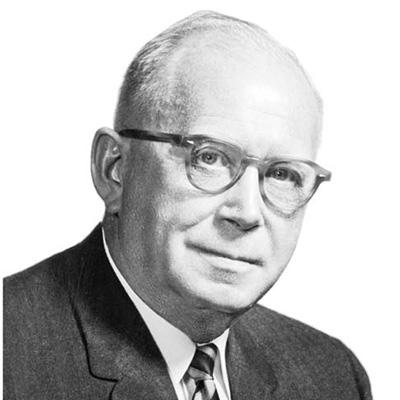Bio
BioRalph Gibson was the third director of APL, serving from 1948 to 1969.
Born in England, Gibson joined the Geophysical Laboratory of the Carnegie Institution of Washington in 1924 after earning his doctorate. During World War II, he became part of the National Defense Research Committee’s rocket propulsion section and later served as the director of research at the Allegany Ballistics Laboratory. In 1946, Gibson joined APL’s nascent postwar guided missile research effort and two years later became the Laboratory’s third director.
As APL’s director, Gibson expanded the Lab’s capabilities and expertise. When guided missile research required propulsion expertise that APL did not have, he brought in experts who would become future APL leaders, including Alexander Kossiakoff, Frank McClure, Richard Kershner, and William Avery. Under Gibson’s leadership, the Laboratory conducted the world’s first experiments on supersonic ramjets, opening the door to the development of the Bumblebee anti-aircraft missiles.
By the mid-1950s, a growing need for more space and privacy than APL’s original Silver Spring, Maryland, facility could provide led Gibson to find a new campus in Howard County, Maryland, with room enough for future facilities. With a new home and strong leadership, APL expanded into the world of submarines and spacecraft. When Russia launched the Sputnik satellite in 1957, the Laboratory tracked it, and the seeds of an APL Space Department germinated. Gibson provided additional funding for the Lab’s space effort that would soon lead to rapid production of satellites and instrumentation and a program called Transit—the world’s first navigation-by-satellite system.
Gibson encouraged the Laboratory to apply its engineering skills to biomedical challenges, which by the 1970s would result in devices such as the first heart pacemaker, a robotic arm, and a low-radiation X-ray device.
Gibson accepted the challenge of directing a postwar institution, tripling APL’s staff over 21 years and broadly expanding its technical capabilities. He transformed APL from a narrowly focused wartime resource to a developer of sophisticated ordnance systems and a pioneer in space science, biomedical engineering, and basic research. Much of APL’s success can be attributed to Gibson’s vision, his top-notch scientific and engineering staff, and a decade of guided missile development that contributed to APL’s deep expertise.
After leaving APL, Gibson became a professor of biomedical engineering at the Johns Hopkins University School of Medicine.
Gibson received a B.Sc. and a Ph.D. in chemistry from the University of Edinburgh.
